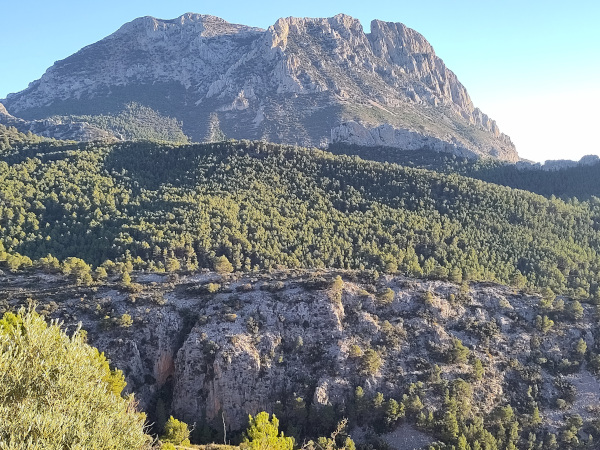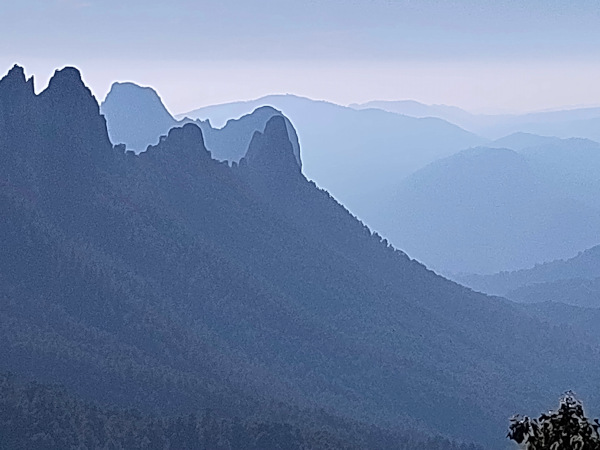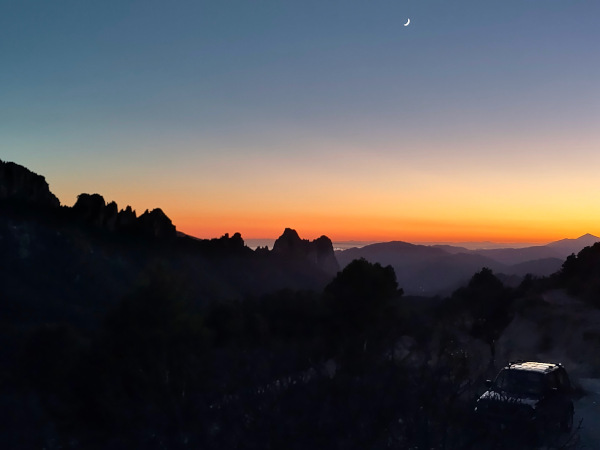On this page we will collect a number of extended descriptions of retreats taken at Uttaraloka.
Cittapala – (Winter 2024)
With the car engine turned off after the long winding track up to the casita, on arriving paradoxically it is the seeming loudness of the still quiet that strikes me: a vibrant silence, apart from a light breeze and odd bird call. It seems to come from the peacefulness of a vast space lighting a succession of hills to the horizon of the sea some 30-50 miles away to the south and the backdrop of the dramatic massif of Puig Campagna to the east, all under a radiantly brilliant clear blue sky. All this beauty commands attention and remains so throughout the various moods of the day from the steely blues before sunrise through the midday sun’s strong brightness, to the dramatic colouring of the sunsets and then deep clarity of the night sky offset by a orange glow of Alicante’s lights in the far distance. It feels enough to allow the quiet to soak in, to simply enjoy and contemplate the views, to drink it all in.


The stone banks, with the terraces’ gnarled trunks and twisted branches of olive and almond speak of another world, secluded from the mundane busyness of the coast’s tourism, the slower more measured rhythm of seasons and nature’s cycles, suggest a mythic realm. This benign face belies other moods that can take grip: sometimes hours of violent gusts of tempestuous winds, driving rain with the land turning to sticky mud, at other times drifting low cloud and mist hiding the mountains and crags, the gloom of grey all around.
The vihara lifestyle that Uttaraloka affords certainly trends in the direction of five attributes of monasticism cited by Bhante: “a) brahmacariya, b) fewness of possessions, c) simplicity of life-style, d) careerlessness, e) community living.” [see Forty-three Years Ago]. And speaks of his exhortation to me (when I was chairman there) that the vitality of our movement would be fed by the opportunity that such places as the Guhyaloka vihara afford.



I love how Uttaraloka is secluded from the hurly-burly visible at night on the far distant coast. Its simplicity encourages slowing down, becoming progressively calmer and undistracted, enjoying a slower rhythm to each day’s unfolding. I’ve found this to be an important annual opportunity, a time to step back, and while taking stock of how I’m living in the UK, time to simply enjoy the beauty, stillness and simplicity of what’s immediately in front of me. Amidst all this, I find it feels easier to relax, to find a different way of being, a way of living that is free from the entangling hindrances of ’normal life’ and one that promotes letting go of ruminating and the conceptual proliferating that habitually clutters my head and heart: ‘cleanse doors of perception’. I’m reminded of Sangharakhita’s exploration in the Ratnagunasamcayagatha seminar where he extols the virtue of learning to live within the mandala of aesthetic appreciation.
While such is quite enough to draw me back each year, these conditions are also ideal for meditating; the Buddha’s words feel apt: “Here a monk, gone to the forest or to the root of a tree or to an empty hut, sits down; having folded his legs crosswise, set his body erect, ….” From enjoying all that the land and life on it embody, it’s natural to savour and take great pleasure journeying into inwardly quieter, stiller, calmer indistractabilty and whole-heartedness. I find the freedom to choose where and when I’m inclined to take this opportunity means I look forward enthusiastically to doing so, by contrast to a long-standing programme-driven habit of reluctantly “meditating because it’s good for me”. I find I thrive on this structureless-ness that contrasts with so many organised retreats, as well as the relentless rounds of my normal life. I enjoy relaxing into trusting my own intuitive inclination, sensing into the deeper currents of what wants to emerge within the spaciousness of ‘not-having-to-do’. This seems the best way to find the balance between the extremes of a wilful pursuit of a ‘productive outcome’ or drifting along ‘wasting time’.
The opening verse of the Ratnagunasamcayagatha raises the all too familiar and natural predisposition to get distracted:
“Call forth as much as you can of love, of respect and of faith!
Remove the obstructing defilements, and clear away all your taints!
Listen to the Perfect Wisdom of the gentle Buddhas,
Taught for the weal of the world, for heroic spirits intended!“
Just sitting in the stillness that saturates the atmosphere at Uttaraloka, it’s considerably easier to notice my tendency to repeatedly get snared in ruminating: compulsively re-running old stories, that reveal deep attachments to entrenched opinions, prejudices, beliefs, the polarising dualisms of worldly winds; indeed the tragedy of the ‘full catastrophe’ of my samskaras. I’ve taken to labelling this procession as just so much “rhubarb” – an immediately humorous popping of these thought-bubbles.
As I let go of my reactivity an emerging clarity encourages me to rest contently in the on-going flow, indeed to listen to the gentle quiet voice of Manjugosha that suggests a much freer way of being with the paradoxical ambiguity and poetic non-dualistic contingent nature of life
